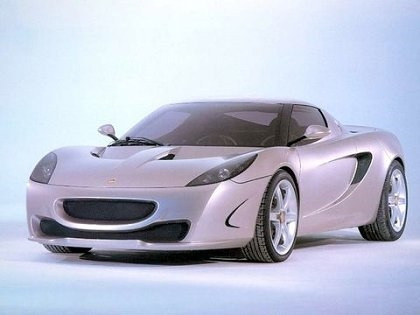





The first glimpse is a revelation. In the half-dark of a small warehouse the M250 stands, extending its desirable tail towards the driver. This is it then, the Lotus of the future. Not as spaced-out as the florid 340R, not as fanciful as the Elise. But instead sublime, elegant and nevertheless full of dynamic strength. This car is a seducer par excellence.
The idea for this breath-taking coupé arose at the Lotus development centre. Here dream sports-cars are not only sketched: they are put on the road. When the concept car was seen by the public for the first time at the Frankfurt Motor Show, the response was so powerful that the first customers wanted to pay five-figure deposits before even leaving the stand. And at that time the dream sports-car consisted only of clay, and there wasn’t even an interior yet. Progress has been made since then. While there is still no name for the former concept car (it will definitely begin with “E”) and future production car, it is certain that the design of the handsome M250 will be 90% adhered to.
It really speaks for itself. The eye glides ecstatically over the clear, simple lines, absorbing the elements of typical Lotus styling. The radiator outlet vent in front of the windscreen, the side air ducts and the restrained rear spoiler integrated with the engine cover. Everything has its logic, everything its purpose. The car is to be fast, light and good-looking. The rear wing serves simultaneously as a handle for opening the enormous engine cover. In the huge maw the gleaming engine is revealed. A 3.0-litre six-cylinder unit putting out 250 bhp. The name for the design project was derived from the power output.
The M250 will enter the contest for customers’ favour between the Esprit (with eight cylinders) and the Elise (with four). Between 3,000 and 4,000 vehicles a year are to be built. Orders accompanied by deposits can already be placed with selected dealers. From spring 2002 the first coupés will come on to the roads. With the declared objective of making things hot for some Porsche 911s. While with its 300 bhp the icon of sports-car building will have distinctly more power than an M250, in the duel the Porsche will probably see only the tail lights of the Lotus. For the dynamic British-made car is intended to pass 100 km/h in under five seconds. In another six seconds it will reach its maximum speed of 250 km/h. Only then will the 911 have the chance by virtue of its higher top-speed (plus 30 km/h) to make up lost ground.
Theoretically the M250 too could be driven in a speed range significantly above 250 km/h.
The equipment for a testdrive is largely complete. The basis is a frame of adhesive-bonded aluminium sheets which is extremely light and at the same time enormously rigid. This concept has proved its worth outstandingly in the Elise; with altered dimensions it is now to be applied to the M250. The chassis, which Lotus are buying complete from the Swedish company Hydro-Aluminium, is to weigh about 75 kg. The frame is spanned by a 4,137-mm long, 1,817-mm wide and only 1,166-mm high body made of composite material. Together with the wide-opening gullwing doors the body must weigh just about 40 kg. The eye-catching door concept is to be retained in order to facilitate getting into and out of the low seat-well.
